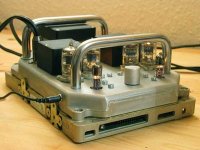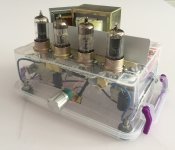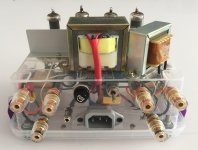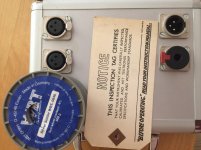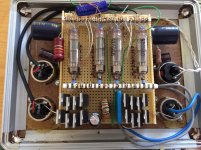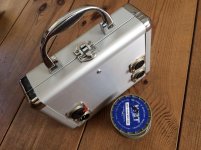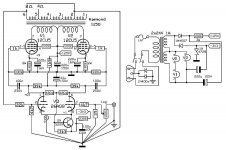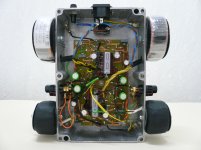Hi
As I made some really nice desktop speakers, I am looking for an amp to go with them. The problem is that I have a small desk @work, so I need a small Amp.
It should be smaller than my favourite mini amp, the mighty midget.
I would like to use two small output transformers, and either a dc power input, like 48V, if possible, or a really small classical transformer.
Around 2X2W or 2X3W is ok, I like SE. Hybrid would also be possible. I found the Elekit Amps but I don't like the design too much.
I am open to Point-to-Point but also PCB's. I can also design PCB's no problem.
Any suggestions / Schematics ? Cool would be an easy design like the bottlehead crack but for speakers... (the SEX is too big)
Thanks a lot in advance
Christoph
As I made some really nice desktop speakers, I am looking for an amp to go with them. The problem is that I have a small desk @work, so I need a small Amp.
It should be smaller than my favourite mini amp, the mighty midget.
I would like to use two small output transformers, and either a dc power input, like 48V, if possible, or a really small classical transformer.
Around 2X2W or 2X3W is ok, I like SE. Hybrid would also be possible. I found the Elekit Amps but I don't like the design too much.
I am open to Point-to-Point but also PCB's. I can also design PCB's no problem.
Any suggestions / Schematics ? Cool would be an easy design like the bottlehead crack but for speakers... (the SEX is too big)
Thanks a lot in advance
Christoph
Dunno… seems to cry "I might best fit a circlophone".
OTL. Compact, small.
It also (to me) sounds doable around really attractively priced "alternate universe" tubes, running in cathode-follower mode. Push pull. For 2–3 watts you need P=I²R; I = √((2–3) ÷ 8 ) = 500 ma to 650 ma of RMS current. Only √((2–3) × 8 ) = 4 to 5 volts of RMS voltage swing. Not much!
(Being an unabashedly OLD fâhrt, for these kind of small-service operations, I'd be reaching for the thick footed TO–3 case NPN and PNP bipolar transistors. They LOVE doing emitter-follower duty in such small ranges. No transformers either! But if one's a “new buck” or a “steampunk valve aficionado”, well … I know that such sacrilege talk of sand-that-amplifies is not to be had here. Bannable offense!)
So, what to do for 600+ ma? 48 volts operating anode voltage; parallel output tubes, running nominally 300 ma ea section. Dunno… NPN-PNP complimentary pairs or MOSFETs look mighty good.
GoatGuy
OTL. Compact, small.
It also (to me) sounds doable around really attractively priced "alternate universe" tubes, running in cathode-follower mode. Push pull. For 2–3 watts you need P=I²R; I = √((2–3) ÷ 8 ) = 500 ma to 650 ma of RMS current. Only √((2–3) × 8 ) = 4 to 5 volts of RMS voltage swing. Not much!
(Being an unabashedly OLD fâhrt, for these kind of small-service operations, I'd be reaching for the thick footed TO–3 case NPN and PNP bipolar transistors. They LOVE doing emitter-follower duty in such small ranges. No transformers either! But if one's a “new buck” or a “steampunk valve aficionado”, well … I know that such sacrilege talk of sand-that-amplifies is not to be had here. Bannable offense!)
So, what to do for 600+ ma? 48 volts operating anode voltage; parallel output tubes, running nominally 300 ma ea section. Dunno… NPN-PNP complimentary pairs or MOSFETs look mighty good.
GoatGuy
Thanks for the ideas... and thoughts. I kind of like the to-3 idea... do you have some schematics in mind?
regards
Christoph
regards
Christoph
If you want to go traditional, a EL84 SET can be made pretty compact. I've done a couple that would fit on a standard 8.5x11 sheet of paper.
2N4905 (PNP) and 2N4914 (NPN) are a great pair. $13 for the two of them. TO–3 cases. Fine specs (VCEBO > 60 V, HFE > 50, great current sinking ability.
However I personally would also employ a tube VFA in front of the output sand crystals. I like the X⅔ triode response curve; I'd not use either a (near-)fixed bias (via LED in cathode) or capacitor-bypassed resistor, I'd just use a straight resistor. If you build a –24:0:+24 supply, you can easily run small triodes at VA ≈ 30 volts. The non-bypassed resistor is a kind of local feedback to only somewhat linearlze the triode VFA. With complimentary sand output, you don't need to "split phase" either. Direct drive. Set a balanced bias-point for each output final, and away you go.
I always put "sense resistors" in the emitters tho'. 0.1 Ω. Allows rather fast DC quiescent measurements, and bias setting. Gets the job done. 2 Ω "series-to-collectors" also works to protect the whole thing, and to further undermine perfect linearity. (Yes: undermine… musically.)
I've run out of time today to cobble schematics together for you. They'll have to wait until I get back.
GoatGuy
However I personally would also employ a tube VFA in front of the output sand crystals. I like the X⅔ triode response curve; I'd not use either a (near-)fixed bias (via LED in cathode) or capacitor-bypassed resistor, I'd just use a straight resistor. If you build a –24:0:+24 supply, you can easily run small triodes at VA ≈ 30 volts. The non-bypassed resistor is a kind of local feedback to only somewhat linearlze the triode VFA. With complimentary sand output, you don't need to "split phase" either. Direct drive. Set a balanced bias-point for each output final, and away you go.
I always put "sense resistors" in the emitters tho'. 0.1 Ω. Allows rather fast DC quiescent measurements, and bias setting. Gets the job done. 2 Ω "series-to-collectors" also works to protect the whole thing, and to further undermine perfect linearity. (Yes: undermine… musically.)
I've run out of time today to cobble schematics together for you. They'll have to wait until I get back.
GoatGuy
I've often fancied making a little amp using 100V line-matching transformers and a couple of 12AU7s or something, to get maybe a watt or two (push pull). Just another thing on my bucket list I suppose.
I am thinking of building a OTL tube amp using 6922 triodes tied to MJE15030, 31 TO220 transistors. using 20- 25 volts on each rail for the transistors and 100v on the tubes.
I will be using the Futterman OTL circuit as the base.
I will be using the Futterman OTL circuit as the base.
The 6SN7 push pull design in my signature sounds perfect for you...
Alternatively, an SE design using an EL86 triode connected per channel would be easy with a low B+.
Alternatively, an SE design using an EL86 triode connected per channel would be easy with a low B+.
Some inspiration.
going all the way from “steampunk” to “steamfunk”. Love it. Nice pic. GoatGuy
Hi
As I made some really nice desktop speakers, I am looking for an amp to go with them. The problem is that I have a small desk @work, so I need a small Amp.
That sounds like the surface of your desk is not big so you could develop the amp vertically like old tower computers and not worry too much about the size of transformers.
That sounds like the surface of your desk is not big so you could develop the amp vertically like old tower computers and not worry too much about the size of transformers.
Great idea. In fact one could disguise a very capable amp in an old CPU tower.
6ak6 is a perfect choice for small amplifiers. The one I built last year does have a PC92 preamplifier tube and Hammond 125ASE output transformers. I built the prototype in a 20x14 cm box, but it will fit in 14x14cm with some extra work. 14x14 cm are also enough for a EL84+ECC83 amplifier with external switching power supply.
Attachments
Hi pcan
14x14 cm sounds great ��
Would you share the schematics for this one ?
I found a possibly similar design here:
Micro Champ Amp - monster.party.hat
small guitar amp with around 2w
14x14 cm sounds great ��
Would you share the schematics for this one ?
I found a possibly similar design here:
Micro Champ Amp - monster.party.hat
small guitar amp with around 2w
Last edited:
Hi pcan
14x14 cm sounds great ��
Would you share the schematics for this one ?
I found a possibly similar design here:
Micro Champ Amp - monster.party.hat
small guitar amp with around 2w
R4 is 1K only? Fender champ uses screen grid current to pull down B+ for preamp tubes on overdrive. That's why the resistor is 10k (10 times more), and the cap is 8 uF only.
My first bass guitar amp that I made in school, was built in a flat wooden toolbox. It produced solid 6W, from a pair of Germanium transistors. The problem then was to find a NPN transistor!
This case looks much better!
This case looks much better!
- Status
- Not open for further replies.
- Home
- Amplifiers
- Tubes / Valves
- very small desktop tube amp schematics
